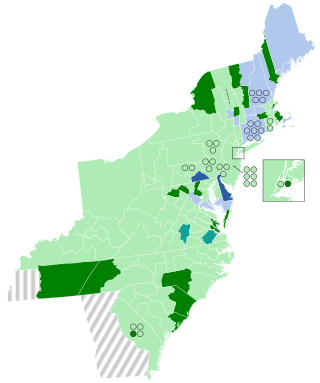| Elections in North Carolina |
|---|
 |
| District | Incumbent | This race | |||
|---|---|---|---|---|---|
| Representative | Party | First elected | Results | Candidates | |
| North Carolina 1 "Roanoke division" | State ratified the U.S. Constitution November 21, 1789. | First member elected March 24, 1790. Anti-Administration win. Winner was later elected to the next term, see below. | √ John B. Ashe (Anti-Administration) 48.9% Nathaniel Macon (Anti-Administration) 41.5% Stephen Moore 8.9% Parsons [lower-alpha 1] 0.7% | ||
| North Carolina 2 "Edenton and New Bern division" | State ratified the U.S. Constitution November 21, 1789. | First member elected March 24, 1790. Anti-Administration win. Winner was later elected to the next term, see below. | √ Hugh Williamson (Anti-Administration) 73.9% Stephen Cabarrus 26.0% | ||
| North Carolina 3 "Cape Fear division" | State ratified the U.S. Constitution November 21, 1789. | First member elected March 24, 1790. Anti-Administration win. Winner later lost re-election to the next term, see below. | √ Timothy Bloodworth (Anti-Administration) 98.4% Benjamin Smith 1.6% | ||
| North Carolina 4 "Yadkin division" | State ratified the U.S. Constitution November 21, 1789. | First member elected March 24, 1790. Pro-Administration win. Winner was later elected to the next term, see below. | √ John Steele (Pro-Administration) [lower-alpha 2] Joseph MacDowell Waightstill Avery | ||
| North Carolina 5 "Western division" | State ratified the U.S. Constitution November 21, 1789. | First member elected March 24, 1790. Pro-Administration win. District covered areas beyond the Appalachian Mountains that were ceded to in May 1790 to form the Southwest Territory, but member retained seat for the remainder of term. | √ John Sevier (Pro-Administration) [lower-alpha 2] | ||





